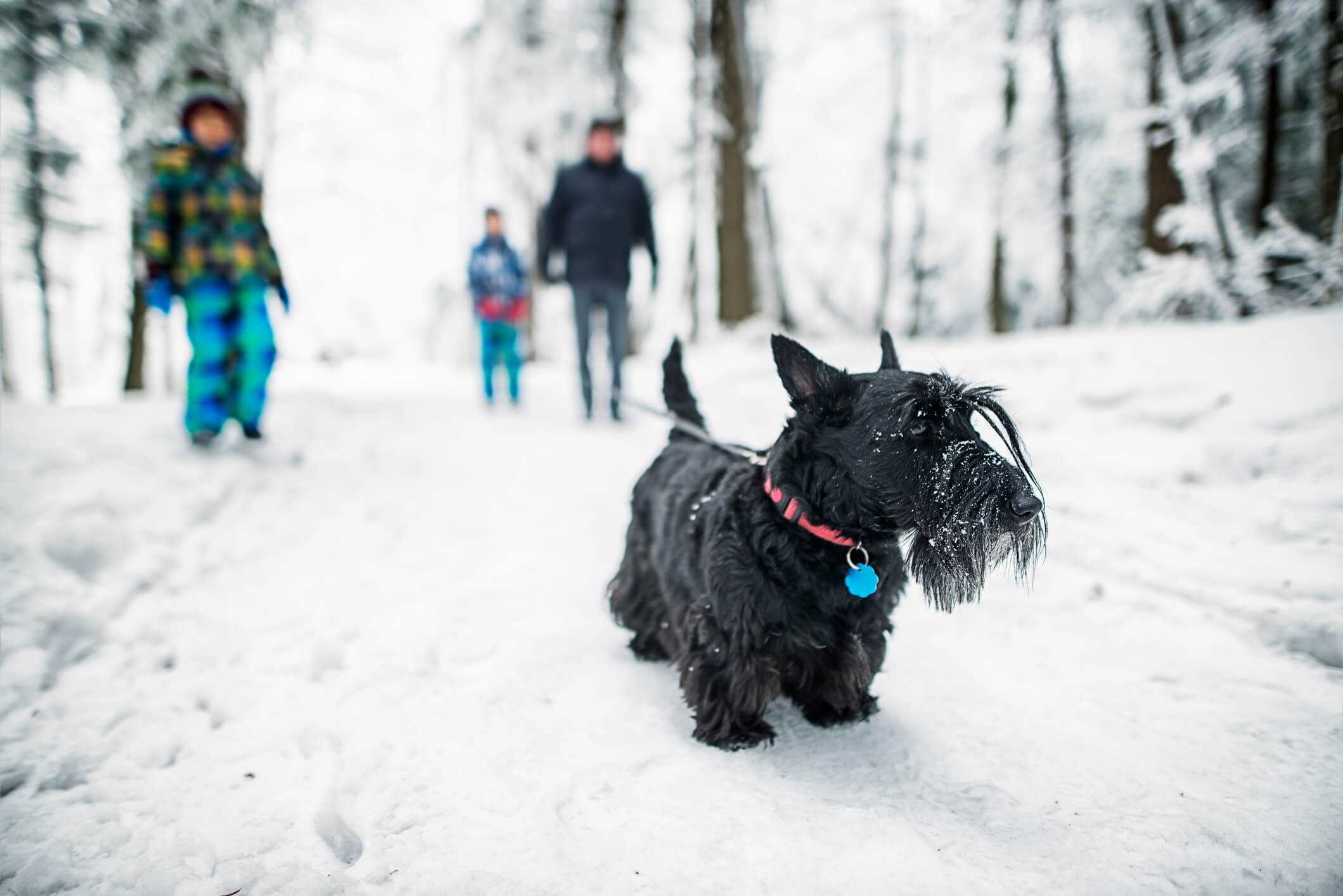
Be Mindful of Antifreeze and De-Icing Salts on Dog Walks
There’s no question as to why humans wear snow boots in winter. The sidewalks are freezing and covered with toxic de-icing salts. If we need protective gear, so do our dogs!
Many pet parents remain unaware of how antifreeze, de-icing salts and cold temperatures damage their dogs’ health. In a handful of cases, winter hazards cause symptoms that quickly turn fatal. Take a moment to identify the hidden dangers in your pup’s winter environment and learn what you can do to protect them during the cold months.
The dangers of winter for dogs
Antifreeze products become more commonplace during the colder months. People apply antifreeze to their car’s windshield and engine cooling system to prevent the formation of ice. Unfortunately, antifreeze is extremely toxic for pets because it usually contains a chemical called ethylene glycol. Antifreeze poisoning leads to lethargy, vomiting, seizures and difficulty breathing.
Dogs may come into contact with antifreeze when owners accidentally spill it in the garage or driveway. The smell attracts dogs, who might try to lick it off the ground. Antifreeze can also accumulate on the paws and fur, which then enters the body when dogs groom themselves.
Another winter product that contains toxic chemicals is de-icing salt. It’s virtually everywhere during winter due to city-wide salt trucks and neighbors trying to melt the ice off their driveways. De-icing salt can accumulate in between a dog’s toes and cause similar symptoms of poisoning if licked off the paws. The chemicals in salt, grit and spray may even burn their paw pads!
How to protect your pup on winter walks
You won’t always have control over your dog’s environment. That’s why dogs need to be prepared for anything they might encounter during the cold months. Pet parents can easily mitigate the dangerous effects of antifreeze and de-icing salts by practicing these winter tips.
- Buy a dog jacket: Jackets can do more than keep your pup warm! Dogs with long, shaggy fur benefit from a winter jacket because it creates a barrier between them and the icy ground. Jackets prevent snow that might contain toxic chemicals from freezing onto your dog’s belly fur.
- Put on some booties: Dog booties drastically reduce the amount of contact your pup has with antifreeze and de-icing salts. They also guard against dryness, cracking, burns and frostbite. Most importantly, your dog will have no poisonous chemicals to lick off their paws!
- Trim fur around the paws: Some dogs won’t tolerate wearing booties. If that’s the case, you can still minimize salt and snow accumulation by trimming the fur around their paw pads. De-icing salt will have less fur to stick to, and your dog will be less likely to get frostbite from frozen snow.
- Avoid heavily salted roads: Salt and grit is impossible to avoid altogether. However, pet parents should still make an effort to skirt around visible grit wherever possible. Cleaner sidewalks or snow-covered lawns are more soothing on the paws and minimize how much gunk you’ll have to get off their feet after the walk.

Pet care after a winter stroll
Even with the appropriate winter gear, dogs need to get cleaned off after winter walks. They can track antifreeze and de-icing salt into the home via their fur and paws. Dogs may attempt to lick off the winter products, which is when poisoning occurs. Follow these steps as soon as you two come home from a walk.
- Wipe off their paws: Remove street gunk by gently wiping your dog’s paws with a clean, damp cloth. Soak the cloth in lukewarm water first, since this can melt frozen snow that’s stuck on fur and in between toes. Don’t use extremely hot water because it may burn sensitive paw pads!
- Look for skin irritation: After a walk, examine your dog’s paws for signs of frostbite, burns, dryness and cracking. Contact your vet if you notice anything out of the ordinary or if your dog appears to be in pain. They can recommend the proper winter gear for your pup, along with pet-safe moisturizers and ointments to treat dryness or burns.
- Use pet-safe winter products: Winter pet care isn’t just about wiping off your dog after walks. Pet parents should make conscious choices about which products they use around the home. Check your local home improvement store for non-toxic alternatives to de-icing salt. Certain brands of antifreeze are free from ethylene glycol or contain a scent that’s meant to deter pets.
Winter is a trying time for our four-legged explorers. The dangers of winter are ever-present, but a few tricks can save your dog from chemical poisoning and skin irritation. Bundle up your pup and head out the door—a winter wonderland full of adventure lies ahead!


